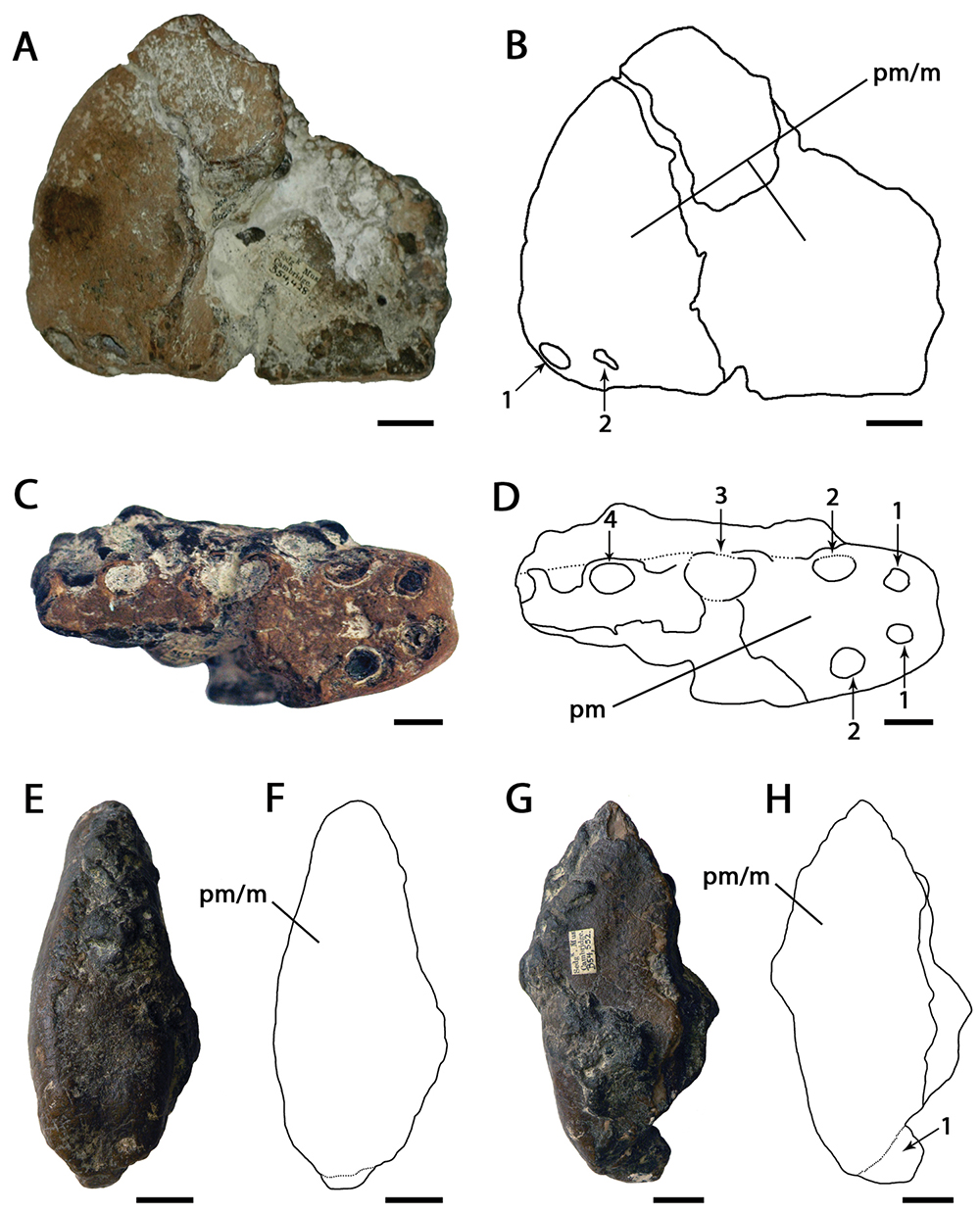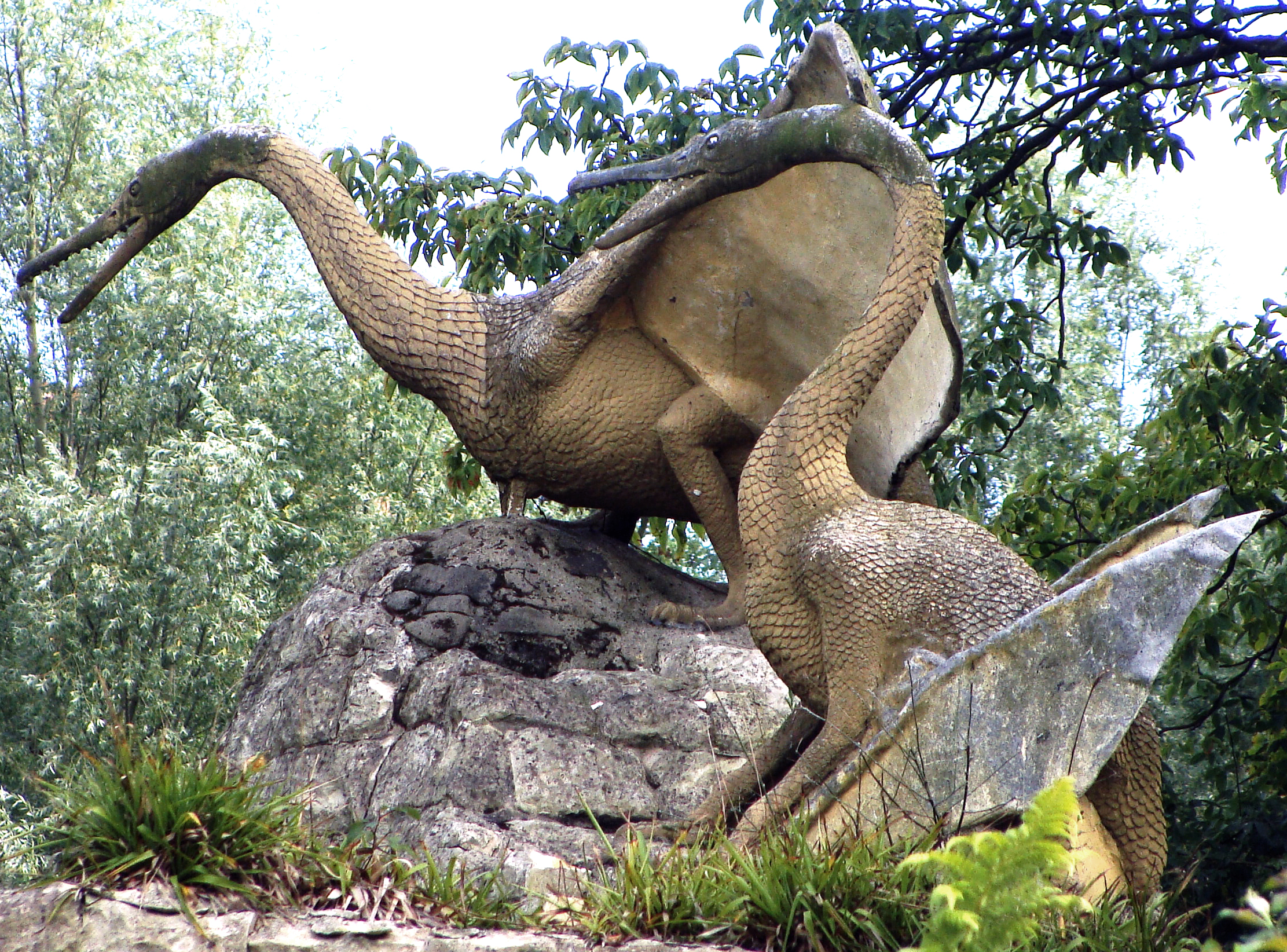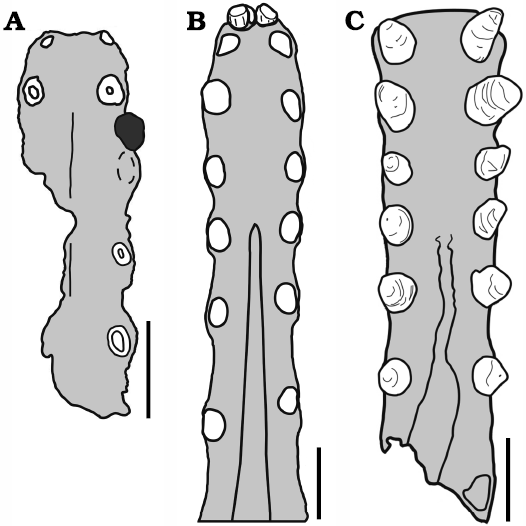|
Ornithocheirid
Ornithocheiridae (or ornithocheirids, meaning "bird hands") is a group of pterosaurs within the suborder Pterodactyloidea. These pterosaurs were among the last to possess teeth. Members that belong to this group lived from the Early to Late Cretaceous periods (Valanginian to Turonian stages), around 140 to 90 million years ago. Ornithocheirids are generally infamous for having an enormously controversial and very confusing taxonomy. Although agreements that these animals were related, and therefore similar to istiodactylids and pteranodontians, there is still no virtual consensus over the exact content and interrelationships of this group. Ornithocheirids were the most successful pterosaurs during their reign, they were also the largest pterosaurs before the appearance of the azhdarchids such as '' Quetzalcoatlus''. Ornithocheirids were excellent fish hunters, they used various flight techniques to catch their prey, and they are also capable of flying great distances without f ... [...More Info...] [...Related Items...] OR: [Wikipedia] [Google] [Baidu] |
Cimoliopterus
''Cimoliopterus'' is a genus of pterosaur that lived during the Late Cretaceous in what is now England and the United States. The first known specimen, consisting of the front part of a snout including part of a crest, was discovered in the Grey Chalk Subgroup of Kent, England, and described as the new species ''Pterodactylus cuvieri'' in 1851. The specific name ''cuvieri'' honours the palaeontologist George Cuvier, whereas the genus ''Pterodactylus'' was then used for many pterosaur species that are not thought to be closely related today. It was one of the first pterosaurs to be depicted as models in Crystal Palace Park in the 1850s. The species was subsequently assigned to various other genera, including ''Ornithocheirus'' and ''Anhanguera''. In 2013, the species was moved to a new genus, as ''Cimoliopterus cuvieri''; the generic name ''Cimoliopterus'' is derived from the Greek words for "chalk" and "wing". Other specimens and species have also been assigned to or synonymi ... [...More Info...] [...Related Items...] OR: [Wikipedia] [Google] [Baidu] |
Pterosaur
Pterosaurs (; from Greek ''pteron'' and ''sauros'', meaning "wing lizard") is an extinct clade of flying reptiles in the order, Pterosauria. They existed during most of the Mesozoic: from the Late Triassic to the end of the Cretaceous (228 to 66 million years ago). Pterosaurs are the earliest vertebrates known to have evolved powered flight. Their wings were formed by a membrane of skin, muscle, and other tissues stretching from the ankles to a dramatically lengthened fourth finger. There were two major types of pterosaurs. Basal pterosaurs (also called 'non-pterodactyloid pterosaurs' or 'rhamphorhynchoids') were smaller animals with fully toothed jaws and, typically, long tails. Their wide wing membranes probably included and connected the hind legs. On the ground, they would have had an awkward sprawling posture, but the anatomy of their joints and strong claws would have made them effective climbers, and some may have even lived in trees. Basal pterosaurs were i ... [...More Info...] [...Related Items...] OR: [Wikipedia] [Google] [Baidu] |
Ornithocheirus
''Ornithocheirus'' (from Ancient Greek "ὄρνις", meaning ''bird'', and "χεῖρ", meaning ''hand'') is a pterosaur genus known from fragmentary fossil remains uncovered from sediments in the UK and possibly Morocco. Several species have been referred to the genus, most of which are now considered as dubious species, or members of different genera, and the genus is now often considered to include only the type species, ''Ornithocheirus simus''. Species have been referred to ''Ornithocheirus'' from the mid-Cretaceous period of both Europe and South America, but ''O. simus'' is known only from the UK, though a specimen referred to ''O.'' cf. ''simus'' is also known from Morocco. Because ''O. simus'' was originally named based on poorly preserved fossil material, the genus ''Ornithocheirus'' has suffered enduring problems of zoological nomenclature. Fossil remains of ''Ornithocheirus'' have been recovered mainly from the Cambridge Greensand of England, dating to the beginn ... [...More Info...] [...Related Items...] OR: [Wikipedia] [Google] [Baidu] |
Ornithocheirus Simus
''Ornithocheirus'' (from Ancient Greek "ὄρνις", meaning ''bird'', and "χεῖρ", meaning ''hand'') is a pterosaur genus known from fragmentary fossil remains uncovered from sediments in the UK and possibly Morocco. Several species have been referred to the genus, most of which are now considered as dubious species, or members of different genera, and the genus is now often considered to include only the type species, ''Ornithocheirus simus''. Species have been referred to ''Ornithocheirus'' from the mid-Cretaceous period of both Europe and South America, but ''O. simus'' is known only from the UK, though a specimen referred to ''O.'' cf. ''simus'' is also known from Morocco. Because ''O. simus'' was originally named based on poorly preserved fossil material, the genus ''Ornithocheirus'' has suffered enduring problems of zoological nomenclature. Fossil remains of ''Ornithocheirus'' have been recovered mainly from the Cambridge Greensand of England, dating to the beginni ... [...More Info...] [...Related Items...] OR: [Wikipedia] [Google] [Baidu] |
Pterodactylus Simus
''Ornithocheirus'' (from Ancient Greek "ὄρνις", meaning ''bird'', and "χεῖρ", meaning ''hand'') is a pterosaur genus known from fragmentary fossil remains uncovered from sediments in the UK and possibly Morocco. Several species have been referred to the genus, most of which are now considered as dubious species, or members of different genera, and the genus is now often considered to include only the type species, ''Ornithocheirus simus''. Species have been referred to ''Ornithocheirus'' from the mid-Cretaceous period of both Europe and South America, but ''O. simus'' is known only from the UK, though a specimen referred to ''O.'' cf. ''simus'' is also known from Morocco. Because ''O. simus'' was originally named based on poorly preserved fossil material, the genus ''Ornithocheirus'' has suffered enduring problems of zoological nomenclature. Fossil remains of ''Ornithocheirus'' have been recovered mainly from the Cambridge Greensand of England, dating to the beginni ... [...More Info...] [...Related Items...] OR: [Wikipedia] [Google] [Baidu] |
Ferrodraco
''Ferrodraco'' ("Iron Dragon" after the ironstone the fossil was found in) is an extinct genus of anhanguerid pterosaur known from the Late Cretaceous Winton Formation of Queensland, Australia, containing the single species ''F. lentoni''. The species was named after the former mayor of Winton, Graham Thomas ‘Butch’ Lenton. It is the most complete pterosaur fossil from Australia, being known from the holotype specimen AODF 876, consisting primarily of the anterior portion of the skull and dentary, cervical vertebral centra and a partial wing. Its wingspan was estimated to be about . ''Ferrodraco'' was found to have been within the subfamily Ornithocheirinae, as sister taxon to '' Mythunga''. A recent study also recovered ''Ferrodraco'' as sister taxon to ''Mythunga'', but both placed within the family Anhangueridae, more specifically within the subfamily Tropeognathinae. ''Ferrodraco'' is also the latest surviving member of Anhangueria. Discovery and naming The holotyp ... [...More Info...] [...Related Items...] OR: [Wikipedia] [Google] [Baidu] |
Coloborhynchus
''Coloborhynchus'' is a genus of pterodactyloid pterosaur belonging to the family Anhangueridae, though it has also been recovered as a member of the Ornithocheiridae in some studies. ''Coloborhynchus'' is known from the Lower Cretaceous of England (Valanginian age, 140 to 136 million years ago), and depending on which species are included, possibly the Albian and Cenomanian ages (113 to 93.9 million years ago) as well. ''Coloborhynchus'' was once thought to be the largest known toothed pterosaur, however, a specimen of the closely related '' Tropeognathus'' is now thought to have had a larger wingspan. History and classification Like many ornithocheiroid pterosaurs named during the 19th century, ''Coloborhynchus'' has a highly convoluted history of classification. Over the years numerous species have been assigned to it, and often, species have been shuffled between ''Coloborhynchus'' and related genera by various researchers. In 1874 Richard Owen, rejecting the creation by ... [...More Info...] [...Related Items...] OR: [Wikipedia] [Google] [Baidu] |
Siroccopteryx
''Siroccopteryx'' is an extinct genus of anhanguerid pterodactyloid pterosaur, known from middle Cretaceous (between the Albian and Cenomanian stages, about 105 million years ago) sediments in modern-day Morocco. Some researchers, such as David M. Unwin, consider the genus a junior synonym of ''Coloborhynchus''. Description The genus was named and described in 1999 by Bryn Mader and Alexander Kellner. The name ''Siroccopteryx'' means "wing of the Sirocco", referring to the warm wind that originates in the North Africa and then goes through the Mediterranean, and the Greek word ''pteryx'', a standard suffix for pterosaur genera that means "wing". The epithet of the type species ''S. moroccensis'' refers to its country of origin. This pterosaur is known only from the front part of the jaw with teeth. The holotype fossil, LINHM 016 (Long Island Natural History Museum), was found near Ksar es Souk, in the province of Errachidia in the region of Meknes-Tafilalet at 30.4 ° N, 4 ... [...More Info...] [...Related Items...] OR: [Wikipedia] [Google] [Baidu] |
Mythunga
''Mythunga'' is a genus of anhanguerid pterosaur from the late Early Cretaceous of Australia. Fossil remains of ''Mythunga'' dated back to the Albian stage of the Early Cretaceous, and the animal itself was found to be a close relative of another Australian anhanguerid called ''Ferrodraco''. Discovery and naming ''Mythunga'' is known from a partial skull, holotype QM F18896 found in April 1991 by Philip Gilmore in marine rocks of the late Albian-age Toolebuc Formation at Dunluce Station west of Hughenden, Queensland. Only the middle snout and corresponding parts of the lower jaws are known, including the rear of a left premaxilla, the lower parts of both maxillae, the rear dentaries and a right splenial. They were three-dimensionally preserved, associated in a chalk nodule. It represents a subadult individual. The fossil was prepared by Angela Hatch of the Queensland Museum, both by mechanical means and by an acid bath. The type species ''Mythunga camara'' was named and descri ... [...More Info...] [...Related Items...] OR: [Wikipedia] [Google] [Baidu] |
Arthurdactylus
''Arthurdactylus'' is a genus of pterodactyloid pterosaur from the Early Cretaceous Crato Formation of northeastern Brazil. It was a medium-sized pterosaur, with a wingspan of and body mass of . It was in 1994 named by Eberhard Frey and David Martill in honor of Arthur Conan Doyle, who featured large reptilian pterosaurs in his novel ''The Lost World'', about a professor finding prehistoric animals still alive on a plateau in South-America. They first spelled the species name as ''Arthurdactylus conan-doylei'', thus with a forbidden diacritic sign, and themselves carried out the necessary emendation to ''conandoylei'' in 1998. The holotype is SMNK 1132 PAL, a reasonably complete skeleton, lacking only a skull, neck, sternum and some caudal vertebrae. The specimen, adult or nearly so, was preserved on a plate and is slightly crushed. ''Arthurdactylus'' had, compared to the torso length of 22 centimetres, relatively long wings and especially long wing fingers, perhaps much more so ... [...More Info...] [...Related Items...] OR: [Wikipedia] [Google] [Baidu] |
Early Cretaceous
The Early Cretaceous (geochronology, geochronological name) or the Lower Cretaceous (chronostratigraphy, chronostratigraphic name), is the earlier or lower of the two major divisions of the Cretaceous. It is usually considered to stretch from 145 Megaannum#SI prefix multipliers, Ma to 100.5 Ma. Geology Proposals for the exact age of the Barremian-Aptian boundary ranged from 126 to 117 Ma until recently (as of 2019), but based on drillholes in Svalbard the defining Anoxic event#Cretaceous, early Aptian Oceanic Anoxic Event 1a (OAE1a) was carbon isotope dated to 123.1±0.3 Ma, limiting the possible range for the boundary to c. 122–121 Ma. There is a possible link between this anoxic event and a series of Early Cretaceous large igneous provinces (LIP). The Ontong Java Plateau, Ontong Java-Manihiki Plateau, Manihiki-Hikurangi Plateau, Hikurangi large igneous province, emplaced in the South Pacific at c. 120 Ma, is by far the largest LIP in Earth's history. T ... [...More Info...] [...Related Items...] OR: [Wikipedia] [Google] [Baidu] |
Pteranodontia
Pteranodontia is an extinct group of ornithocheiroid pterodactyloid pterosaurs that lived during the Late Cretaceous period (Coniacian to Maastrichtian stages) of North America and Africa. They were some of the most advanced pterosaurs, and possessed highly specialized cranial crests that may have served as sexual attraction, with males having a much larger crest. Classification Pteranodontia was originally named by Marsh in 1876. In 2003, it was given a phylogenetic definition by David Unwin as the common ancestor of ''Pteranodon'' and '' Nyctosaurus'' plus all its descendants. Though Marsh had originally named this group based on the shared absence of teeth in those species, most analyses show that all of the traditional "ornithocheiroid" pterosaurs are also members of this clade. Below is a cladogram showing the phylogenetic placement of this group from Andres and Myers (2013). In 2018, Longrich, Martill, and Andres revisited the classification, and made a different phylogen ... [...More Info...] [...Related Items...] OR: [Wikipedia] [Google] [Baidu] |








